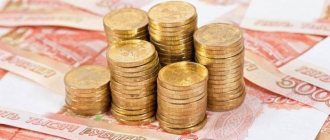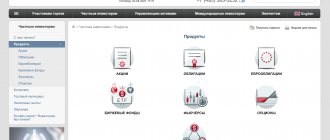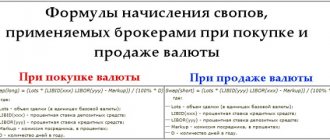The stock market is a turbulent and unstable business. It is influenced by thousands of different factors that exist both inside and outside the market. Exchange trading is especially susceptible to sudden and rapid changes. It was the constant jumps in the price of a particular asset that gave rise to the concept of volatility.
Volatility - what is it in simple words
Volatility is a period that characterizes the variability of the price of a certain asset, recorded at a certain time, which allows one to make predictions about subsequent market behavior resulting from fluctuations in value in the past. Simply put, it is the difference between the highest and lowest price over a period of time. Volatility is closely related to financial risk management, as it itself is a measure of the risk of a financial instrument.
Origin of the term "volatility"
The term “volatility” in Russian comes from the English term “volatility”, which in turn goes back to the French “volatilis”, which means “volatile”, “changeable”, “fast”. The word itself contains the essence of the concept. Volatility is a change, in this case, a change in the price of a certain asset (money, precious metals, bonds, etc.) over a certain period of time.
How to calculate
Volatility is calculated in several ways:
- In absolute terms. If a currency pair has passed 50 pips during a trading session, then this is its daily volatility.
- In percentage terms. For example, on the previous day the stock closed at 100 rubles, and according to the results of the current session its value was 103 rubles. In this case, the daily volatility of the security is 3%.
Historical volatility is calculated as a value equal to the standard deviation of the return on a financial asset over a given period of time.
The parameter is calculated based on historical data on the value of the instrument. Average annual volatility is proportional to the standard deviation of the return of a financial instrument and inversely proportional to the square root of the time period.
The dynamics of fluctuations over a given period of time is calculated based on average annual volatility.
Volatility indicators
There are special tools that calculate price volatility and the amplitude of its fluctuations, which allows you to draw up a future prospect for the purchase of a particular asset. Presented by a fairly wide list:
- Average True Range (ATR) is the simplest indicator that shows the average current maximum and minimum price of a currency pair. To use it, a current daily chart is opened, on which ATR data is superimposed: if the volatility is high, the indicator grows, if it is low, it falls.
- Volatility Average Single High Limit - this indicator allows you to assess the state of the market using several indicators (single average and increased average volatility). It can be used in trading strategies as a filter for trading signals, identifying false and true breakouts.
- Bollinger Bands - here volatility reflects the volatility of the value of a currency pair with a limited range of price fluctuations. If the stripes here remain in a “narrow corridor” state, then there is a high probability of expecting a rise or fall in the rate.
- CCI is a tool based on the technology of assessing falling and rising “candlesticks” that determine points for exiting or entering a trade.
- Notis - measures market volatility using the difference between the high and low prices. Designed not only to measure volatility, but also to determine the phases and directions of the trend.
Factors influencing volatility
There are several such factors:
- The liquidity of a security is the ability and speed of its conversion into actual cash. If it is low, then fewer investors will want to invest in it, and vice versa.
- Expectations of exchange participants . When, before important economic decisions, executives are expected to make statements regarding a particular security. It is at such times that it is characterized by increased volatility.
- The state of the economy as a whole - everything is simple here: a stable state means low volatility, and vice versa.
- Margin Trading – Exchanges limit the volume of margin trading to reduce market fluctuations. This helps protect against speculators. It is important to draw the limit for margin trading in a timely manner.
- Internet trading - as the number of people with enough experience and knowledge is increasing. They introduce a certain imbalance into the market, so they can engage in “trading games”. The increase in the number of speculators has no less impact.
What factors influence
Let's consider the factors influencing volatility:
- type of asset – cryptocurrencies, derivative financial instruments (options, futures), commodities (oil, gas, precious metals) are considered highly volatile; bonds and blue chip stocks will be less volatile;
- economic events - markets react sharply to decisions of central banks to change the key rate, the release of statistical indicators (oil reserves, unemployment and inflation rates, GDP), the release of financial statements of companies;
- political events - elections, political scandals, statements about the imposition of sanctions;
- extraordinary events - natural disasters, pandemics, man-made disasters, military conflicts, terrorist attacks;
- Loud statements by influential people - tweets from Donald Trump, Elon Musk - have always led to sharp price fluctuations in financial markets.
More than 100 cool lessons, tests and exercises for brain development
Start developing
Currency volatility may be affected by:
- liquidity – the more in demand a particular currency is in the world, the less susceptible it is to sharp fluctuations;
- dependence of the national currency exchange rate on one sector of the economy - for example, in Russia the ruble exchange rate is strongly influenced by prices in the oil and gas sector, an increase in volatility in it leads to an increase in the volatility of the ruble;
- monetary policy of the state - for example, the refusal of the Central Bank of Turkey to raise the key rate amid rising inflation has now led to the collapse of its national currency.
Signs of volatility
Despite the fact that this ratio determines the volatility of assets over a period of time and each situation gives it individual characteristics, there are some common features:
- The desire for an average value is manifested precisely due to cyclicity, since no matter what point the value is at, it will always tend to the middle in order to avoid extremes.
- A sign of consistency - interested investors have reason to think that if a certain level of volatility was present today, then it should appear tomorrow.
Types of volatility
- Historical (or current) - a value equal to the real price change over the past period of time. What is interesting here is not only the direction of market movement, but also its speed. It allows you to determine the average value of the volatility indicator for a particular financial instrument.
- Expected (or potential) - necessary for making calculations of a statistical indicator based on the current value with a further forecast of the situation in order to predict possible risks as much as possible.
- Expected historical is already the history of the expected level of variability over a time interval.
Volatility: high and low, when is it better to earn money?
With low volatility, it is difficult for active traders to make money. This state of the market suggests that large players are not taking any action, and only small speculators are left on the exchange floor, trying to pump up quotes. Traders who trade linear instruments are better off staying on the sidelines in this situation. In an inactive market, you can make money by selling naked options, but this is an extremely risky strategy.
The optimal option is moderate volatility with clearly defined trends. In such a market, it is easiest to determine the level of entry into a position, the size of leverage, the size of orders to fix a loss and take a profit.
For positional trading, an important parameter is the cyclicality of the market. For example, some stocks can rise for 4-5 days, followed by a correction.
With high volatility, the range of fluctuations in price quotes increases sharply. This means that exchange players have not decided on the further direction of movement of the financial asset, and are reacting violently to incoming news.
Such a market provides great opportunities for speculators, but the risks also increase many times over. During periods of extreme volatility, it is recommended to reduce the level of leverage (or completely abandon it) and set tight stop losses.
With extremely high volatility, a trader needs to be prepared for any surprises. The exchange may increase margin lending requirements at any time. If threshold values for financial instruments are reached, a temporary suspension of trading cannot be ruled out. The size of slippage increases significantly, stop orders may not be executed.
Examples of use in life
In practice, this method of risk management can be useful for assessing the movement of a particular indicator, for example, for making decisions: how risky it is to open a transaction or the sequence of actions in relation to it at a certain value of the asset.
- Low volatility can be represented by the following situation: during the year the price of bread was 20 rubles and did not increase, but by the end of the year it increased by 3 rubles and became 23 - volatility is 15%.
- High volatility using the example of the same bread: it cost 20 rubles and every month the price increases by 3 rubles, by the end of six months the price became 38 rubles. Volatility was 90%.
All this happens with assets on the stock exchange: the level of volatility depends on how the value of the asset changes.
Volatility of currency pairs
You can calculate the range between prices for the corresponding currencies per unit of time by estimating the distance of one “candle” (that is, between the maximum and minimum prices) in points, for example, for one trading day. But, if you count on a week, the indicator will have a completely different value, so the arithmetic average of a sample of “candles” is often used. This involves predicting growth or decline based on past value. This is the volatility of currency pairs.
Most often, the volatility of currency pairs depends on the trading session, which depends on the opening and closing of exchanges, as well as the intersection of various trading sessions. In general, everything depends on the rhythm of the market. Publications related to macroeconomics also have a significant influence in certain countries.
Volatility indicators. Why are they useful for traders and investors?
In 2022, volatility returned to the US stock market. It has also intensified on other financial platforms. How to measure volatility and apply the data obtained? In our training material we will cover this topic.
In general, volatility is a measure of the volatility of a financial asset, that is, how much quotes change over a given period of time. They highlight intraday volatility, which is useful for short-term traders. Changes within a month or quarter are useful for mid-term players. If we are talking about a year or more, then this is already a field for activity of long-term investors, although there is no longer volatility, but rather trends.
Volatility indicators are used in assessing various assets (stocks, currencies, commodities, etc.), as well as markets in general. We also have an important component for working with options.
The general principle is this: the higher the volatility, the higher the risks, that is, uncertainty. Moreover, the higher the risks, the higher the profitability. The main thing is to assess in advance your inclination and readiness to take risks - your psychological portrait and financial conditions. Part of this requires expert judgment. Well, volatility indicators will help you mathematically calculate the volatility of assets.
Historical volatility
Calculated based on historical data. For this purpose, a statistical indicator is used - the mean square deviation (RMS, standard deviation, σ). It shows how much the rate of growth or decline of securities (yield) deviates from the average value for the period under consideration (mathematical expectation, ?).
Method for calculating standard deviation
Stage 1. Upload daily quotes for the security in question for the selected period of time into Excel.
Stage 2. We calculate the daily yield of the security for each day using the formula LN(Xn/Xn-1). Where Xn is the price value on day n.
Stage 3. We calculate the daily volatility of the security using the STANDTOKLN.V formula (the entire range of previously calculated daily returns).
Step 4. If we want to see how the price has changed over a certain period of time (week/month/year), then we must multiply the resulting standard deviation value by the root of N. Where N is the number of trading days in the period that we want to convert. So, for example, for a week it will be 5, for a year 250.
It is useful to recalculate daily volatility approximately once every quarter. Calculations are possible using weekly and even monthly timeframes; it all depends on the investment time horizon. The longer the historical period, the longer timeframes should be used.
Three sigma rule: almost all values of a normally distributed random variable lie in the interval (?-3σ; ?+3σ), that is, they do not deviate from the mathematical expectation by more than 3 standard deviations. One sigma rule: in 68% of cases the deviation occurs by no more than 1 standard deviation.
Individual assets
The higher the amplitude of fluctuations, the more opportunities there are for speculators. At the same time, strong volatility of an asset can put psychological pressure on the investor, forcing him to deviate from the chosen strategy. This is why it is so important to comply with margin requirements and choose the right leverage depending on your trading style.
Short- and medium-term fluctuations of an asset are determined by the dynamics of supply and demand in the market. Shares can be influenced by corporate events (reporting, dividends, data on new products, changes in top management, etc.), general sentiment (investor sentiment), as well as market movements as a whole. In the case of commodity assets, messages about changes in production, demand for raw materials, in particular, geopolitical news are more important. Currencies are often influenced by macroeconomic data, messages about the monetary policy of central banks, and the actions of other regulators.
Example: the volatility of the stocks shown in the chart is 14.3% and 36%, respectively. In this case, fluctuations occur within the trend.
Pay attention to reviews of the most volatile securities on the Russian and American stock markets from BCS Express experts>>
There is a measure of beta (β) that shows how much a stock is outperforming the broader market. Beta is the ratio of the covariance of security and stock index returns to the dispersion of the index returns. For example, for the American market, the classic benchmark is the S&P 500. Covariance is calculated in Excel using the formula COVARIANCE.V, dispersion using the formula - VARIANCE.V.
If beta is greater than 1, then the stock rises and falls more than the index. When beta < 1, the amplitude of movements is less sharp. At zero there is no dependence, and at -1 it is the opposite. As practice shows, over long periods of time there are no stocks with a beta equal to or less than zero.
Volatility indicators have found application in technical analysis. The most popular indicator is Bollinger Bands. Graphically, the indicator consists of three lines: a moving average in the middle, characterizing the main direction of movement, and two lines limiting the price chart on both sides and characterizing its volatility. The upper and lower lines are the same moving average, but shifted by several standard deviations.
A movement that starts from one of the borders will most likely continue to the other. If the boundaries of the channel diverge, this indicates a continuation of the existing trend, and if the outer Bollinger Bands narrow, this may indicate a fading trend and a possible reversal.
Read more in the special review “Bollinger Band Indicator or How to Tame Volatility”
In the long term, we are talking about a trend and cyclical fluctuations around it. Long-term deviations may depend on the phases of the economy, technological and industrial cycles. This is no longer volatility, which is more of a technical issue, but fundamental movements. This is especially noticeable in the US stock market, where the secular trend is bullish, despite moments of crisis.
At the same time, the secular trend is divided into a number of multi-year trends (bullish and bearish), often set by economic cycles. The current bull trend in the US market has been ongoing since 2009. Short- and medium-term volatility occurs within multi-year trends and can be confusing for investors. The main thing is not to confuse local changes with long-term dynamics.
Briefcase
Diversification will help reduce portfolio volatility. Standard deviation is used in a number of models. The most famous is the Markowitz model. The goal of the model is to compile an optimal portfolio, that is, with minimal risk and maximum profitability.
The risk of an individual instrument is assessed as the standard deviation of its return. To calculate the overall risk of a portfolio, it is necessary to reflect the cumulative change in the risks of an individual instrument and their mutual influence (through covariances and correlations - measures of relationship). Within the framework of a properly selected portfolio, risks are reduced due to the inverse correlation of instruments. This eliminates not only the specific risks of the instrument, but also reduces the systematic (market) risk.
Read more in the special review “Creating an investment portfolio according to Markowitz for dummies”
Weakness of the Markowitz model: future returns are based only on the historical value of security returns and do not include the influence of macro-, micro- and behavioral factors. In the real world, if a stock has been falling for a long time, the expected return is more likely to be positive. This is true not only for the portfolio, but also for individual securities.
Implied volatility
Implied volatility is calculated based on option prices (premiums). The Black-Scholes model is often used to value options, which assumes that option premiums are directly related to the volatility of the underlying asset.
There are times when the price of an option changes regardless of the price of the underlying asset. This is especially obvious during periods of tension in the market, when important news is released. An excess of implied volatility over historical volatility indicates overbought options and, accordingly, fear of market participants, while an excess of historical volatility over implied volatility, on the contrary, characterizes the fearlessness of investors at the current moment in time.
Indicators related to implied volatility are useful for assessing the sentiment or sentiment of market participants. The most famous of them is the VIX “fear index”, which shows the state of the American stock market, its direction and sentiment, assessing the implied volatility of options on the S&P 500 index. The pattern of the indicator is such that when the market falls, the volatility index rises, and when the market rises, the volatility index is decreasing.
According to the basic theory, if the VIX value is above 40-45, then this indicates panic in the market and investors fleeing risky assets. Such situations arise when prices are at lows and it’s time to think about long-term purchases. If the value drops to 20 or lower, then the markets are experiencing a growing trend and it seems that this will continue for a long time. In the area of long-term lows, it’s time to think about closing long positions. It's the extremes that are important, although the VIX can lie low for a long time, giving false signals for a long time.
Additionally, there are times when discrepancies appear between the logical inverse correlation of the S&P 500 and the VIX. Divergences of this kind very often become harbingers of a reversal of the main trend in the market.
In addition to the VIX, there are indicators such as:
1) RVI - volatility of the Russian RTS index;
2) OVX - oil volatility;
3) GVX - gold volatility, etc.
Volatility indices can be purchased speculatively in anticipation of market shocks, and can also be used to hedge a portfolio. Read a special review on this topic “How to “buy” the volatility index”
Summing up
Volatility can be a speculator's friend, but it can interfere with a long-term investor's plans. This is why it is useful to track indicators of price volatility. Volatility can be “buyed” or “sold”, built into technical analysis, and is useful for assessing risks and selecting securities to buy or sell. The main postulate is this: the higher the risks, the higher the profitability, and vice versa. The main thing is to find a balance between the desire to earn money and the willingness to bear potential risks.
Read the best materials on the American market on the BCS USA channel on Telegram
Open an account
BCS Broker
Ruble volatility
When the ruble is volatile, any currency pair is taken into account - most often the dollar or euro. If volatility is high, then this is an indicator of a lack of stability in the market, hence poorly predictable situations. But a decrease in the indicator indicates stability, without crisis processes.
The main factors of ruble volatility are:
- Central Bank Policy;
- Country credit risks;
- Global Politics;
- Oil price;
- Capital flight;
- Speculation on the stock exchange.
Cryptocurrency volatility
The volatility of the value of a cryptocurrency lies in the variability of its exchange rate: the difference between the upper and lower limits of the price. Calculated based on data for several months or a year.
Cryptocurrencies are subject to the slightest fluctuations in non-economic and economic factors and events in the cryptosphere as a whole. The rate of completely new and still unknown cryptocurrencies can fluctuate without any particular reason: sometimes the fall or rise of a major currency, for example, Bitcoin, is enough.
The cryptocurrency is very volatile, so traders do not know what to expect from it. There are several other significant factors:
- Not regulated by the government;
- There is no connection to tangible value (no dependence on the price of any value of the nation);
- No real cost;
- The behavior of inexperienced traders who buy and sell at the wrong time.
Such volatility is very difficult to predict, and therefore carries high risks for investors, but it is gradually being introduced into the traditional economy.
Impact of volatility on the economy
Volatility, first of all, can affect the economy both negatively and positively.
- Its negative impact is that price jumps, sometimes sharp, make people in the markets nervous, lose money, and make hasty and wrong decisions. It can also affect the supply and demand of certain goods, hence production suffers, and therefore the profitability of enterprises.
- A positive impact is that production is being modernized, ways to support volatility are being developed, since calm in the markets has a positive effect on banks and companies, under these conditions they are more inclined to issue shares and bonds, but low volatility has a very negative impact on trading profitability.
Volatility in general is quite clear and simple. This is a natural and logical phenomenon of the market, which regulates its relations from the inside and directly affects the income of banks, companies and private investors. Strategies on the stock exchange depend on volatility - hence the importance of understanding what it is, and some of the difficulties in applying this concept in practice.
- Related Posts
- Useful tips on how to choose a New Year's gift according to your zodiac sign
- 20 common mistakes portfolio investors make
- Gold and foreign exchange reserves: importance for the economy
How to calculate volatility yourself
It makes no sense for a non-professional investor to calculate the expected volatility on his own: experience and understanding of the derivatives market are needed. It's easier to study it in the index.
But you can calculate historical volatility yourself if you really want to. Any spreadsheet program has a standard deviation function. Let's say we downloaded the results of daily trading in Tesla shares for March 2022, transferred the file to Google Sheets and cleaned it up a little: we separated the date and stock price at which the exchange stopped working into different columns. Now we can calculate the historical volatility of the company.
First, we calculate the daily profitability using a simple formula: B2/B1−1. We stretch it to the end and convert the value into percentage format:
Knowing Tesla's profitability, we can calculate daily volatility. Mathematicians would say that you need to calculate the standard deviation. We will simply use the formula STANDARDEVAL, also known as STDEV - take the return as an interval and again convert it into a percentage:
It turns out that the automaker has high volatility. Let us remind you that a deviation of 1–3% is considered low.
If you want, we can also calculate monthly volatility, to do this we multiply the daily volatility by the root of the number of trading days:
There is a third, more accurate option for measuring historical volatility. It is more suitable for math maniacs, the formula is:











